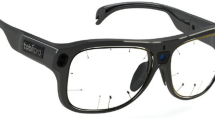Abstract
Recognizing activities of daily living is useful for ambient assisted living. In this regard, the use of wearable cameras is a promising technology. In this paper, we propose a novel approach for recognizing activities of daily living using egocentric viewpoint video clips. First, in every frame, the appearing objects are detected and labelled depending if they are being used or not by the subject. Later, the video clip is divided into spatiotemporal bins created with an object-centric cut. Finally, a support vector machine classifier is computed using a spatiotemporal flexible kernel between video clips. The validity of the proposed method has been proved by conducting experiments in the ADL dataset. Results confirm the suitability of using the space-time location of objects as information for the classification of activities using an egocentric viewpoint.






Similar content being viewed by others
References
Economic and Financial Affairs (2017) The 2018 ageing report: underlying assumptions and projection methodologies. Technical report, European Commission
Colby S, Ortman JM (2015) Projections of the size and composition of the U.S. population 2014 to 2060. Department of Commerce, Economics and Statistics Administration, technical report, U.S., p 2015
Cardinaux F, Bhowmik D, Abhayaratne C, Hawley MS (2011) Video based technology for ambient assisted living: a review of the literature. J Ambient Intell Smart Environ 3:253–269
Nguyen T-H-C, Nebel J-C, Florez-Revuelta F (2016) Recognition of activities of daily living with egocentric vision: a review. Sensors 16(1):72
Hodges S, Berry E, Wood K (2011) Sensecam: a wearable camera that stimulates and rehabilitates autobiographical memory. Memory 19(7):685–696
Rodriguez M, Orrite C, Medrano C, Makris D (2016) A time flexible kernel framework for video-based activity recognition. Image Vis Comput 48:26–36
Queiros A, Dias A, Silva AG, Rocha NP (2017) Ambient assisted living and health-related outcomes: a systematic literature review. Informatics 4(3):19
Blackman S, Matlo C, Bobrovitskiy C, Waldoch A, Fang ML, Jackson P, Mihailidis A, Nygård L, Astell A, Sixsmith A (2016) Ambient assisted living technologies for aging well: a scoping review. J Intell Syst 25(1):55–69
Reissner L, Gabriella F, List R, Giovanoli P, Calcagni M (2019) Assessment of hand function during activities of daily living using motion tracking cameras: a systematic review. Proc Inst Mech Eng H J Eng Med 233:095441191985130
Martin SK, Jude HD (2017) Hand posture and gesture recognition techniques for virtual reality applications: a survey. Virtual Real 21(2):91–107
Rodríguez M, Orrite C, Medrano C, Makris D (2017) Fast simplex-hmm for one-shot learning activity recognition. In: 2017 IEEE conference on computer vision and pattern recognition workshops, CVPR workshops 2017, Honolulu, HI, USA, July 21–26, 2017. IEEE Computer Society, pp 1259–1266
Martin SK, Jude HD (2019) A probabilistic model for state sequence analysis in hidden Markov model for hand gesture recognition. Comput Intell 35(1):59–81
Pirsiavash H, Ramanan D (2012) Detecting activities of daily living in first-person camera views. In: IEEE conference on computer vision and pattern recognition (CVPR). IEEE
McCandless T, Grauman K (2013) Object-centric spatio-temporal pyramids for egocentric activity recognition. In: British machine vision conference, BMVC 2013, Bristol, UK, September 9–13, 2013
Matsuo K, Yamada K, Ueno S, Naito S (2014) An attention-based activity recognition for egocentric video. In: IEEE conference on computer vision and pattern recognition, CVPR workshops 2014, Columbus, OH, USA, June 23–28, 2014, pp 565–570
Wang H, Schmid C (2013) Action recognition with improved trajectories. In: 2013 IEEE international conference on computer vision, IEEE, Sydney, Australia, Dec 1–8 2013. https://doi.org/10.1109/ICCV.2013.441
Fathi A, Farhadi A, Rehg JM (2011) Understanding egocentric activities. In: 2011 IEEE international conference on computer vision (ICCV). IEEE, pp 407–414
Lazebnik S, Schmid C, Ponce J (2006) Beyond bags of features: spatial pyramid matching for recognizing natural scene categories. IEEE Conf Comput Vis Pattern Recognit (CVPR) 2:2169–2178
Zhou Y, Ni B, Hong R, Yang X, Tian Q (2016) Cascaded interactional targeting network for egocentric video analysis. In: 2016 IEEE conference on computer vision and pattern recognition, CVPR 2016, Las Vegas, NV, USA, June 27–30, 2016. IEEE Computer Society, pp 1904–1913
Wang M, Luo C, Ni B, Yuan J, Wang J, Yan S (2018) First-person daily activity recognition with manipulated object proposals and non-linear feature fusion. IEEE Trans Circuits Syst Video Technol 28(10):2946–2955
Zou Z, Shi Z, Guo Y, Ye J (2019) Object detection in 20 years: a survey. CoRR. arXiv:1905.05055
Liu L, Ouyang W, Wang X, Fieguth PW, Chen J, Liu X, Pietikäinen M (2020) Deep learning for generic object detection: a survey. Int J Comput Vis 128(2):261–318
Jiao L, Zhang F, Liu F, Yang S, Li L, Feng Z, Rong Q (2019) A survey of deep learning-based object detection. IEEE Access 7:128837–128868
Rodriguez M, Orrite C, Medrano C (2017) Space-time flexible kernel for recognizing activities from wearable cameras. In: Alexandre LA, Sánchez JS, Rodrigues JMF (eds) Pattern recognition and image analysis. Springer, Cham, pp 511–518
Jebara T, Kondor R, Howard A (2004) Probability product kernels. J Mach Learn Res 5:819–844
Bishop CM (2006) Pattern recognition and machine learning (information science and statistics). Springer, New York
Choi J, Wang Z, Lee S-C, Jeon WJ (2013) A spatio-temporal pyramid matching for video retrieval. Comput Vis Image Underst 117(6):660–669
Zhang S, Nugent C, Lundström J, Sheng M (2018) Ambient assisted living for improvement of health and quality of life. Informatics 5(1):4
Damen D, Doughty H, Farinella GM, Fidler S, Furnari A, Kazakos E, Moltisanti D, Munro J, Perrett T, Price W, Wray M (2020) The EPIC-KITCHENS dataset: collection, challenges and baselines. CoRR. arXiv:2005.00343
Acknowledgements
This work was supported by the Spanish Project TIN2017-88841-R (M. de Economia, Industria y Competitividad/FEDER, UE).
Author information
Authors and Affiliations
Corresponding author
Additional information
Publisher's Note
Springer Nature remains neutral with regard to jurisdictional claims in published maps and institutional affiliations.
Rights and permissions
About this article
Cite this article
Rodriguez, M., Orrite, C. & Medrano, C. Space-time flexible kernel for recognizing activities from wearable cameras. Pattern Anal Applic 24, 843–852 (2021). https://doi.org/10.1007/s10044-020-00942-0
Received:
Accepted:
Published:
Issue Date:
DOI: https://doi.org/10.1007/s10044-020-00942-0




